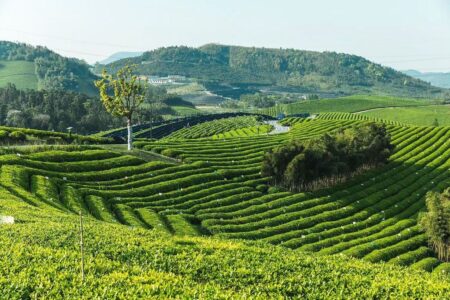Teas from Indonesia Strive to Regain Volume and Profile

With an ideal geographic allocation close to the equator, high peaks and volcanic soils, the tea plant is thriving in Indonesia, but is not profitable enough compared to other cash crops.
By Barbara Dufrêne Photos courtesy of Barbara Dufrêne
Introduced under the Dutch colonial rule during the 18th century, tea and coffee growing has generated a long period of highly profitable export trade with continental Europe. In 1945, at the end of World War II, Indonesia gained independence and Sukarno became the first president of the Republic of Indonesia. With a population of over 264 million people, the Indonesian Archipelago is spread out between continental Asia and Australia, with five big and more than 17,000 small islands, all together comprising a surface of over 1.9 million km². Indonesia is the world’s biggest Muslim country, and has hundreds of ethnic groups and over 700 regional languages.
Java, the most populated island – registering almost 10 million inhabitants – also houses the Republic’s capital city Jakarta, with its port a major trading hub for more than 1,000 years. Crossed by the equator, Indonesia has a tropical climate with abundant rain and sunshine throughout the year. The country has vast areas of arable lands with fertile soils, which makes it one of the world’s major producers of global commodities such as palm oil, natural rubber, rice, coffee, tea, cocoa and tropical spices. Indonesia belongs to the G20 and is a founding member of the World Trade Organisation (WTO), the former GATT.
Currently, Indonesia ranks as the world’s leading producer of palm oil, cloves and cinnamon, and the fourth leading producer of coffee. The ranking for tea dropped to seven in 2015, with an output of 129,300 metric tonnes (mt), compared with 164,800 mt just 10 years ago. In 1957, the government decided to introduce Indonesian ownership for most agricultural productions, and all the remaining Dutch-owned tea and coffee estates were nationalised, taken over by the government to become state-owned plantations, or PTPNs, with the target to earn foreign currency. Tea was a profitable product at that time and Indonesia was ranked as the world’s fourth-biggest tea producer. Tea flourished until global over-production made the prices slump badly from about 2000 onwards, with small farmers gradually switching to other cash crops, in particular, palm oil.
Tea, together with coffee, was introduced by the Dutch colonial rulers as revenue-producing crops for exports to Europe, together with the rare and precious local spices. All the estates were owned by colonial landlords, the local populations supplied the labour and their chiefs were in charge of delivering the crops to the Dutch administrative officers. The poverty and famine generated in Java by the Dutch administration had raised concerns and demands for a more liberal outlook, allowing private commercial interests to be involved in the production of export cash crops. In that political context, a Dutch colonial civil servant published a book in 1860, with the title Max Havelaar, or the Coffee Auctions of the Dutch Trading Company, pleading for more social justice and fairer trade. The name ‘Max Havelaar’ has since become synonymous with the global fair trade movement and the author is still admired as a hero in Indonesia.
Current State of the Tea Market
Today, Indonesian tea production volume is shared out as follows: 40 percent comes from state-owned plantations, 26 percent from private estates and 34 percent from smallholders. Whilst the tea acreage harvested by the state-owned companies amounts to 30 percent, of the private owners, 24 percent and 46 percent are harvested by the smallholders, showing quite a gap in the yield rates.
West Java, the traditional heartland of tea cultivation in Indonesia, still accounts for more than two-thirds of tea output. Central Java, parts of Sumatra and more recently, some parts of Kalimantang contribute the remainder. These islands sit on the Pacific Ring of Fire, with more than hundred active volcanoes and their abundant highlands provide hilly slopes and valleys with fertile volcanic soil, thus offering outstanding environmental conditions for growing tea. A traditional producer of smooth and aromatic black tea, Indonesia has picked up the growing demand for green tea in the West, with green teas today accounting for over 20 percent of the output. With specialty teas trending and with foreign investments, countries with restricted acreage available, such as Taiwan and Japan, have also introduced some fine Wulong teas, grown and manufactured mainly for export. There are also some high quality white teas, made from a special cultivar, which was registered by the Indonesian Research Institute for Tea and Cinchona (IRITC) in Gamboeng, West Java, in 2009. This white tea also has high theanin content and antioxidant properties.
Dr Rohayati Suprihatini, in charge of tea research at the IRITC, explained that several research reports from China and from Indonesia assess that Indonesian teas have a higher catechin content compared with teas from other producing countries. While this can be considered a valuable competitive advantage, the drawback is that Indonesian teas appear to contain higher levels of anthraquinones, a molecule listed as undesirable in the EU. Whilst occurring naturally in several plants, anthraquinones seem to be also generated by the process of smoking food. Currently, research is ongoing to see whether the many forest fires that have destroyed part of the Indonesian rainforest in the past decade may be the origin of that problem. A delegation from the Tea Board of Indonesia plans to meet the EU officials in charge to discuss the matter and to ask for waiving these maximum residue levels (mrls), which have been severely impacting their tea exports to Europe in the recent years.
In 2004, tea exports amounted to 60 percent of the production in Indonesia, with over 30,000 mt going to Europe and the USA. By 2015, tea exports declined to a mere 48 percent of the production, with only 11,900 mt exported to Europe and the USA.
Indonesia’s large state-owned tea plantations, such as Mitra Kerinci in West Sumatra, are the main suppliers to the Jakarta tea auctions and account for the bulk of exports. They do, however, suffer from administrative red tape and lack of investments and many are reported to operate with little or no profit currently. The major private growers are Kabepe Chakra and Gunung Slamat, which manufacture both standard tea products and also high quality and innovative teas.
Olivier Scala CEO of G Cannon, a Paris, France-based importer, wholesaler and retailer, believes that there are some very fine estate teas from Dewata, Kassomalang or Malabar for example, which he continues to carry for retail although they are rather expensive. Feedback from other European importers, FX Delmas, founder of Palais des Thés and Philip Miles, the former CEO of Van Rees BV, indicate that Indonesian teas are perfect for blending and for flavoured teas, but do not, in general, offer the specific qualities of single origin and terroir teas. Their overall conclusion is that new impetus and good marketing would help to build up good profile, although the current Western quality requirements are difficult to comply with.
While state-owned companies source most of their green leaf from their own plantations, the private tea estates buy an important share of their raw material from the surrounding smallholder farmers, who are a key element of the supply chain and contribute over one third of the volume. Unilever Indonesia, a subsidiary of the world’s leading tea packer, purchases tea from state-owned and private plantations to produce a wide range of teas for the home market, both under its own Lipton brand, and under the very popular local Sari Wangi brand, which it acquired a few years ago.
There is also a high performing ready-to-drink (RTD) tea products range (bottles and cans), which meet a growing consumer demand for refreshment in this populous tropical country.
Attempting Improvements and Revival
The Tea Board of Indonesia is highly concerned by the ongoing decline of the country’s tea economy, which faces replacing tea with other crops because of unprofitable prices and is losing export markets through non-tariff barriers. In addition, there is a trend for increased coffee consumption and imports of low-cost teas from Vietnam take away more market shares. Therefore, Rachmat Badruddin, chairman of the Tea Board of Indonesia, has been ringing the alarm bell with the government for the past few years. He is also a private tea grower, CEO of the Kabepe Chakra Company, owning five tea estates in West Java, which he took over from his father in 1990 and is now assisted by his son.
Proud of the Indonesian tea culture and fully aware of the country’s ideal conditions for growing fine crop, Badruddin outlined his proposals for improvements and revival. “In order to participate in the increasingly competitive global tea market, we need:
- to increase the domestic output by using more high yield and high quality botanicals, and modern manufacturing equipment;
- to ensure a better empowerment and training of our many smallholder farmers;
- to get protection for the home market by setting appropriate duty rates on imported teas;
- to introduce more proactive marketing to raise the cup’s quality profile from traditional to trendy at home in order to increase the current low per capita consumption; and
- to carve out a bigger share of the premium tea niche in the export markets.”
International Tea Conference
Aware of the negative effects on rural employment and the environment, which is generated by the decline of the tea industry, the government has been slow to take action, but Badruddin said that the Tea Board of India will continue to press for improvements and to endeavour to make Indonesian tea great again. He trusts that there is a silver lining on the horizon and that the overall growth in tea consumption will also benefit Indonesia in the coming years.
Indonesia has taken further action to foster exchanging knowledge, technology and science with the hope of improving tea economies in a fast-changing world, as well as social issues and climate change. An International Tea Conference has been scheduled to take place in Indonesia at the Bali Convention Centre from 18-20 October this year. The event has full government support and is organised by the Indonesia Research Institute for Tea and Cinchona (IRITC).
Barbara Dufrêne is the former Secretary General of the European Tea Committee and editor of La Nouvelle du Thé. She may be reached at: b-dufrê[email protected].



